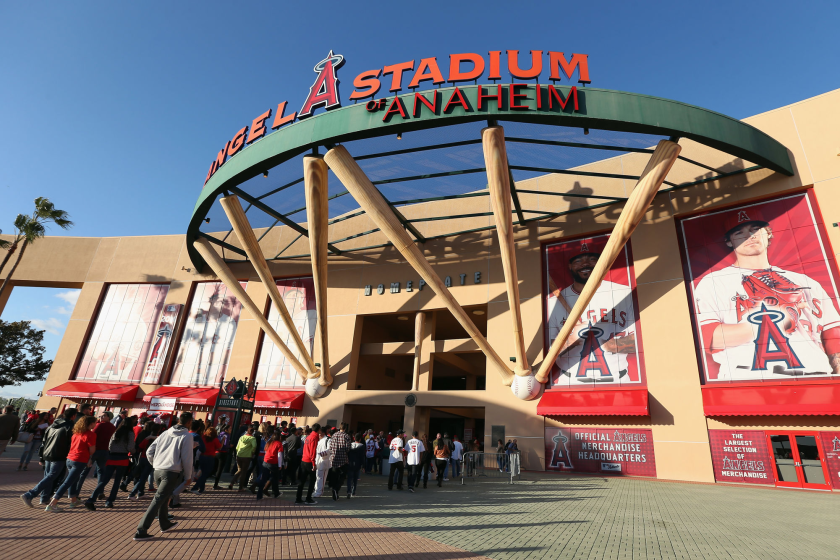Case of Missing Ligament Gets Draftee Out of Joint
- Share via
It may not be the biggest or most important story as baseball approaches a possible labor agreement and the September stretch drives, but it definitely is one of the stranger developments in the history of the amateur draft.
On Wednesday, the Texas Rangers signed their first-round pick and the 18th player selected in the June draft, pitcher R.A. Dickey of the University of Tennessee, for $75,000.
Considerably less than the previously agreed to $810,000.
An anatomical oddity cost Dickey the difference.
Medical examinations ordered by the suspicious Rangers disclosed that Dickey, a member of the U.S. Olympic team, has no ulnar collateral ligament in his right elbow.
The ligament is the main support for the elbow. It can fray and tear, necessitating a reconstructive process known as Tommy John surgery, named for the pitcher who pioneered it.
A tendon may eventually have to be taken from Dickey’s left forearm and built into his right elbow as a ligament, but not immediately.
Dr. Lewis Yocum, the Angels’ orthopedic specialist and one of the most respected in the country, said he had never heard of a pitcher without an ulnar ligament.
“Anything is possible congenitally, but in reality it has to be very rare,” he said.
According to the Rangers, doctors were not sure if Dickey was born without the ligament or it disintegrated when he was a youngster in a painful physical implosion of which Dickey would almost certainly been aware.
“It seems to be the most bizarre thing anybody has ever heard of,” Dickey said by phone, adding he has never had arm problems and was known for his durability at Tennessee.
In three seasons he set school records for victories, innings, strikeouts and appearances.
He threw 182 pitches in an 11-inning victory over Oklahoma State in an NCAA regional final.
The Rangers were concerned when Dickey did not pitch well on the Olympic tour but chalked it up to a tired arm.
The concern was compounded, however, when their orthopedic consultant, John Conway, saw a picture of Dickey on the cover of Baseball America and did not like the position of the elbow.
Dickey arrived in Dallas on Thursday to accept the Rangers’ $810,000 offer but was told he would first need a physical.
Conway said it looked like a torn ligament but wanted a second opinion.
Dr. James Andrews in Birmingham conducted two imaging tests to make sure that what he thought he was seeing was what he was seeing, called in his radiologist from a day off to validate it, and said there was no ligament.
“It was like winning the lottery and then losing the ticket,” Dickey said.
Yocum called it strange, indeed.
“To pick it up off a picture is a real longshot,” he said. “I wonder if Dr. Conway would like to go to the races with me.”
The parimutuels changed dramatically for Dickey. The Rangers, feeling the elbow would eventually collapse without a ligament, withdrew their offer.
That was Tuesday, two days before the shocked Dickey would have returned to classes at Tennessee as a senior.
On Wednesday, the Rangers reconsidered, offering $75,000 and the promise of medical help if Dickey needed it.
General Manager Doug Melvin said Dickey represented an unusual problem, weighing the risk of signing him against receiving a compensation pick after the first round of next year’s draft if they didn’t sign him.
“On the one hand, we have concerns about the elbow and had to treat it like he’s a nameless, faceless kid and do what’s best for the organization,” Melvin said.
“On the other hand, we had thought enough about his ability and heart and the type kid he is to draft him in the first round when we didn’t know about the elbow. He never missed a turn in college. We looked at how good he is at 21 without a ligament and decided we could always get him one somewhere if it turned out he needed one.”
Melvin laughed as he said it.
There are players in baseball and other sports who operate without knee ligaments, but they can use supportive braces. A pitcher can’t.
Dickey would need the reconstructive surgery, but Melvin said the Rangers felt empathy as they heard Dickey talk about his love for the game and his family’s needs--”he was almost in tears when we withdrew the offer”--and concluded he was dedicated enough to endure the long rehabilitation if surgery is ever required.
Said Dickey, who knew his bargaining leverage would evaporate after his senior year, particularly with every club aware of his physical situation:
“I would like to have had that [$810,000] to take care of my family, but I’ll get it when I get to the big leagues.”
Can he get that far with no ligament?
“Nolan Ryan never had much of a ligament, but his mechanics were so good that he could sustain the stress,” Yocum said.
Ryan’s ligament did eventually rupture, forcing him to retire--at 46, prematurely.
GREAT EXPECTATIONS
Some of those are on display at Dodger Stadium this weekend.
In Rey Ordonez and Edgar Alfonzo, the New York Mets have introduced a shortstop and second baseman who might fill those roles for a decade, along with new right fielder Alex Ochoa.
Left fielder Bernard Gilkey and center fielder Lance Johnson, who leads the National League in hits after leading the American League in hits last year, are having productive seasons, and catcher Todd Hundley has become an offensive force.
However, a season of promise has dissolved for the Mets. The road back to the championship level of the ‘80s took a wrong turn.
The expectations, built primarily on a group of talented young pitchers who would revive memories of Tom Seaver and Dwight Gooden, disintegrated.
It was as if the expectations became an albatross for the highly touted but inexperienced Paul Wilson and Jason Isringhausen.
Too much was expected too soon, and now Dallas Green, the manager who had spent most of the season trying to provide a security blanket, reminding reporters that his young pitchers were being force-fed and needed time to mature, has taken to ripping them.
A sure sign that Green does not expect to be retained in 1997? Many close to the club believe that.
The youngsters are still the foundation. The front office can’t afford to let their confidence suffer because of assaults from within. The Mets must make a decision by September 15 on Green’s 1997 option. Bobby Valentine may be asked to rebuild the expectations.
In the meantime, Isringhausen, 9-2 as a rookie last year, is 5-13 with a 4.85 earned-run average and on the disabled list with problems that Green has said are as much mental as physical.
Wilson, the first player selected in the 1994 draft and a veteran of only 37 minor league games, is 4-10 with a 6.55 ERA after losing to the Dodgers Saturday.
And Bill Pulsipher, the third of the young lions, hasn’t pitched after undergoing reconstructive elbow surgery in April and recently complaining that his arm feels worse than it did before the surgery.
Empathy? Green says he has dished out enough of it to Isringhausen and Wilson.
“These guys really don’t belong in the big leagues,” he recently told New York writers. “I know that’s harsh and negative, but what have they done to get here?
“If you talk about developing a player, the object is they’re prepared and ready to play in the big leagues.
“All we want, all we’ve asked for, is something to work with, but we don’t get that. We don’t get it with the fastball, the arm angle or mound presence. We don’t get it with grit or determination. There’s only so many wake-up calls. What they have to do over the winter is look in the mirror, let it sink in.”
Booming honesty has just about always been Green’s policy, but it may not be the best policy if he’s looking to return.
LABOR AGREEMENT
The Mets are close to a multi-year deal with Gilkey, which will knock one more player off that original list of 20 who could become free agents if a new labor agreement credits players with service time for the 75 regular-season days they were on strike. Two of the 20, Chuck Knoblauch of the Minnesota Twins and Mickey Morandini of the Philadelphia Phillies, signed multi-year extensions in the last three days. The Mets’ signing of Gilkey would reduce the list to 17.
Among them: Alex Fernandez of the Chicago White Sox, Moises Alou and Mel Rojas of the Montreal Expos and Tim Naehring of the Boston Red Sox.
A labor agreement would finally put the Expos in position to retain some of their own, since revenue sharing could bring the low-revenue Expos up to $55 million over the life of a six-year contract.
The Twins’ signing of Knoblauch to a five-year, $30-million deal seemed to underscore the belief that a settlement will be reached this week.
The Twins, like the Expos, oppose restoration of service time but can’t afford to give up revenue-sharing rewards similar to Montreal’s.
Both of those clubs could receive as much as $12.5 million per year when revenue sharing takes full effect near the end of the six-year proposal.
Sources said management negotiator Randy Levine may be instructed by acting Commissioner Bud Selig to make one more attempt to get the union to accept a modified restoration of service time when talks resume Monday, but the general perception is that the players will ultimately get full credit in exchange for union concessions in the area of arbitration, strike litigation and their sixth-year option.
Although his industry has been rocked by three years of labor strife, Selig has refused to take a public position on the proposed settlement.
It is believed he has the 21 votes necessary to ratify and won’t bow to the opposition from White Sox owner Jerry Reinsdorf.
NAMES AND NUMBERS
--Chicago Cub General Manager Ed Lynch said the season-ending broken hand suffered by Sammy Sosa represented “the most disappointing news I’ve gotten in my professional career.” Sosa, with 40 homers and 100 runs batted in, was on pace to become the first National Leaguer to hit 50 home runs since George Foster in 1977 and the first to hit 50 and steal 20 bases since Willie Mays in 1956.
More to Read
Go beyond the scoreboard
Get the latest on L.A.'s teams in the daily Sports Report newsletter.
You may occasionally receive promotional content from the Los Angeles Times.






